One of the really handy things about some blog postings is that they are a diary entry that I can refer back to months or years from now. So let it be noted that on this beautiful, warm and sunny Saturday, April 9, 2011, I 'harvested' my latest batch of compost. Whoopee! Well, I don't think it's going to make the 6 o'clock news, but if I say so myself it might just be my finest batch yet, and I have scientific evidence to back up this claim. I had better start explaining, though...
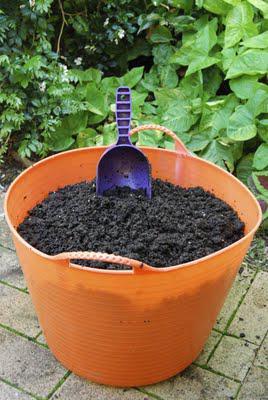 This is only some of the latest batch, but as this is the nicest photo in this set (and let me tell you, compost is not photogenic) I will start with this one. This is compost as I like it: dark, crumbly, gently earthy in smell without any really noticeable smell, and certainly without any kind of unpleasant 'pong'. And while I'm lingering on this shot, aren't trugs wonderful things? I have several, because my garden is too small for wheelbarrows. Anyway, back to the compost, please projectionist!
This is only some of the latest batch, but as this is the nicest photo in this set (and let me tell you, compost is not photogenic) I will start with this one. This is compost as I like it: dark, crumbly, gently earthy in smell without any really noticeable smell, and certainly without any kind of unpleasant 'pong'. And while I'm lingering on this shot, aren't trugs wonderful things? I have several, because my garden is too small for wheelbarrows. Anyway, back to the compost, please projectionist!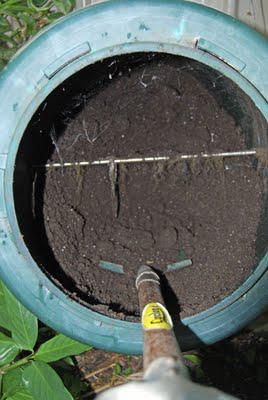 Told you it's not photogenic. But here's the compost being extracted from my large 'tumbler' bin which does all the composting work around here.
Told you it's not photogenic. But here's the compost being extracted from my large 'tumbler' bin which does all the composting work around here.  And this is where the latest batch of compost goes: into my original old 'Dalek' bin, which is a pretty hopeless compost bin, but a perfectly good place to store lots of ready-to-use compost. The tumbler bin is a much better bin because it's easy to spin it around to aerate the compost. Air is one of the most important ingredients in compost and Dalek bins are fairly hopeless because it's not easy to use a garden fork to get in there and 'stir' the contents, to introduce air into the heap.
And this is where the latest batch of compost goes: into my original old 'Dalek' bin, which is a pretty hopeless compost bin, but a perfectly good place to store lots of ready-to-use compost. The tumbler bin is a much better bin because it's easy to spin it around to aerate the compost. Air is one of the most important ingredients in compost and Dalek bins are fairly hopeless because it's not easy to use a garden fork to get in there and 'stir' the contents, to introduce air into the heap. 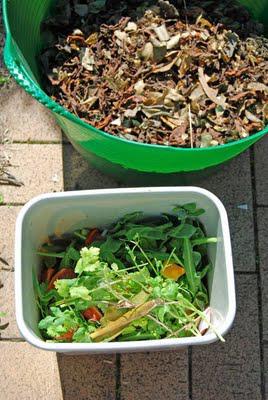 At the end of the half-hour operation to transfer all my made compost into the Dalek bin, the tumbler is ready to do it all again. I always leave a couple of shovels-full of made compost in the tumbler, to help get the breaking down process going again on the new stuff. And here's the first lot of ingredients ready to go in: vegie scraps from the kitchen (these are fresh 'wet' ingredients) and to balance them out some 'dry ingredients', fallen leaves from around the garden. When there aren't fallen leaves available I use a couple of handfuls of straw garden mulch from the mulch bag, or if I'm really desperate, shredded newspaper (but the newspaper always seems to take ages to break down, so it isn't my favourite). However the main thing is always to balance out the 'wet' with the 'dry'. Maintaining this wet-dry balance and aerating the heap are the two main basics of composting to pay attention to.
At the end of the half-hour operation to transfer all my made compost into the Dalek bin, the tumbler is ready to do it all again. I always leave a couple of shovels-full of made compost in the tumbler, to help get the breaking down process going again on the new stuff. And here's the first lot of ingredients ready to go in: vegie scraps from the kitchen (these are fresh 'wet' ingredients) and to balance them out some 'dry ingredients', fallen leaves from around the garden. When there aren't fallen leaves available I use a couple of handfuls of straw garden mulch from the mulch bag, or if I'm really desperate, shredded newspaper (but the newspaper always seems to take ages to break down, so it isn't my favourite). However the main thing is always to balance out the 'wet' with the 'dry'. Maintaining this wet-dry balance and aerating the heap are the two main basics of composting to pay attention to.However there is another magic ingredient which has turned this compost batch (I only make one a year, on average, by the way) and that is lime. And here's the 'proof' I was talking about earlier.
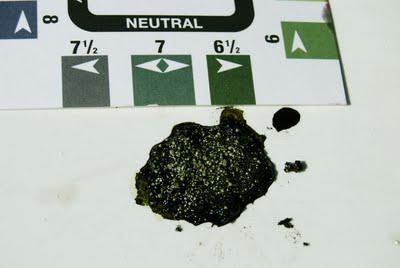 Go on, call me 'a bit keen' but I pH test my compost! It's a bit hard to see the colour of the compost sample in the photo, but in natural light it's speckled with darkish green dots, and you match the colour of the sample to the chart provided to establish the pH reading. Here, the acidity of my compost is somewhere between 6.5 (very mildly acid) and 7 (neutral). This pH testing idea occurred to me a few years ago. I thought that with so many kitchen scraps in our compost, there was a chance it might be too acid. And pH tests confirmed the hunch. It's just silly to dig in stacks of overly acidic compost when what you're really trying to do is improve your soil, not ruin it. And since then I have been adjusting the acidity of my compost as I go, by adding in some dolomite lime from time to time.
Go on, call me 'a bit keen' but I pH test my compost! It's a bit hard to see the colour of the compost sample in the photo, but in natural light it's speckled with darkish green dots, and you match the colour of the sample to the chart provided to establish the pH reading. Here, the acidity of my compost is somewhere between 6.5 (very mildly acid) and 7 (neutral). This pH testing idea occurred to me a few years ago. I thought that with so many kitchen scraps in our compost, there was a chance it might be too acid. And pH tests confirmed the hunch. It's just silly to dig in stacks of overly acidic compost when what you're really trying to do is improve your soil, not ruin it. And since then I have been adjusting the acidity of my compost as I go, by adding in some dolomite lime from time to time. 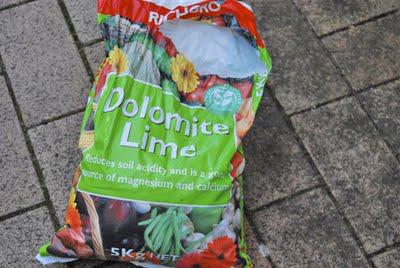 You can use horticultural lime to raise the pH reading if you like, but I prefer this stuff, dolomite lime, which is essentially just rock crushed down to almost a powder. It is slower and gentler in its action than lime, but it gets the pH adjusting job done. As the packet says, it's also a good source of magnesium and calcium.
You can use horticultural lime to raise the pH reading if you like, but I prefer this stuff, dolomite lime, which is essentially just rock crushed down to almost a powder. It is slower and gentler in its action than lime, but it gets the pH adjusting job done. As the packet says, it's also a good source of magnesium and calcium.I don't add in the dolomite lime every time I add some vegies and dry stuff to the compost bin, but I do probably end up doing it once a month, roughly, just whenever I remember. A good handful each time.What do I use compost for? I dig it into vegie beds as part of soil preparation. I mix some in with potting mix to beef up the mix with some home-made goodness. When planting seedlings I like to dig a hole, fill it with compost, then plant the seedling into that. Vegie seedlings always seem to belt along when planted into compost. You can use compost as a mulch, too. It's great stuff, just not photogenic!
